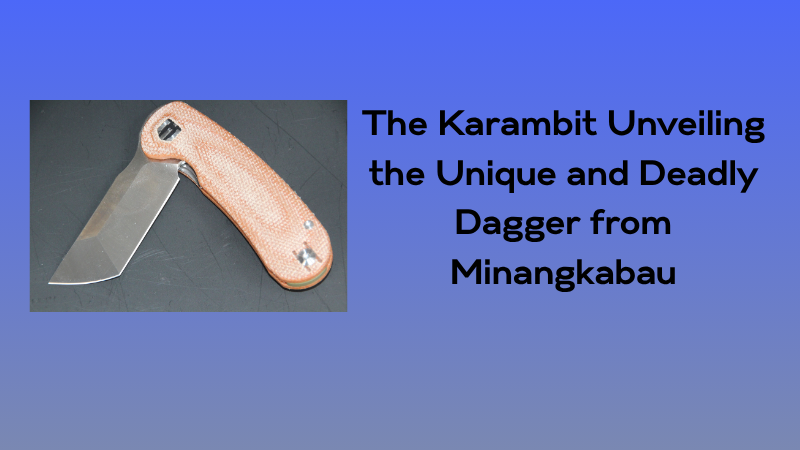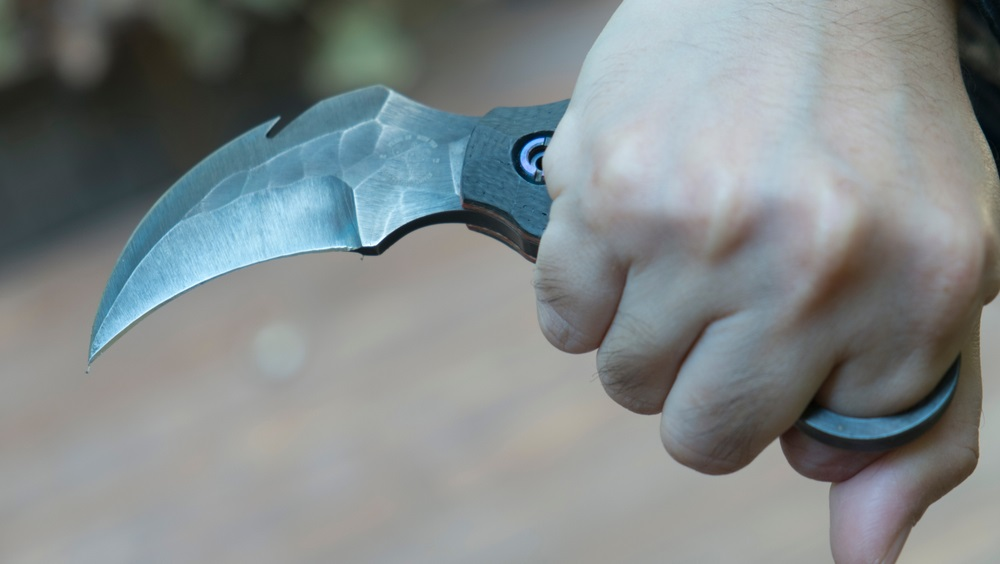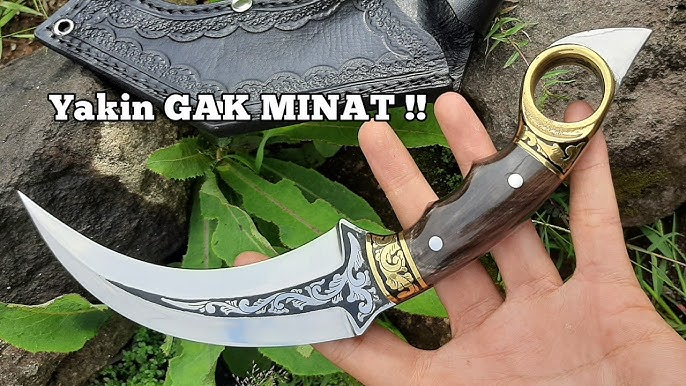
The Karambit: Unveiling the Unique and Deadly Dagger from Minangkabau
In the heart of Sumatera Barat, Indonesia, lies a cultural treasure that has captivated martial arts enthusiasts and historians alike—the Karambit, a traditional dagger steeped in history and intrigue. This unique weapon, originating from the Minangkabau region, is not only a symbol of local heritage but also a testament to the ingenuity and resilience of the Minang people. The Karambit, with its distinctive curved design and lethal efficiency, has become a subject of fascination worldwide. In this article, we delve into the history, techniques, and cultural significance of this iconic dagger, exploring why it is considered one of the most dangerous weapons in the world.

The History of the Karambit
The Karambit is a traditional weapon from Minangkabau, a region in Sumatera Barat, Indonesia. Its name is derived from the Minang language, where "kurambik" refers to a claw-like weapon. The origins of the Karambit are deeply rooted in the cultural and historical context of the Minangkabau people, who are known for their rich traditions and martial prowess.
Historically, the Karambit was not just a weapon but also a tool for daily life. Many traditional weapons in Nusantara, including the Karambit, were initially used for agricultural purposes. Farmers would use the Karambit to clear weeds, harvest crops, and perform other tasks related to farming. However, its potential as a weapon soon became apparent, and it evolved into a deadly instrument for self-defense and combat.
The Karambit's design was inspired by the claws of tigers, which were abundant in the forests of Sumatera. The Minangkabau people, adhering to their philosophy of "Alam takambang jadi guru" (Nature is our teacher), drew inspiration from the tiger's ferocity and agility in battle. The curved shape of the Karambit mimics the tiger's claw, allowing for precise and devastating strikes.
Initially, the Karambit was reserved for the elite—royal families and high-ranking officials—who saw it as a symbol of power and status. Its use was often shrouded in secrecy, and only select individuals were trained in its techniques. Over time, however, the Karambit spread beyond Minangkabau, reaching other parts of Indonesia and even neighboring countries in Southeast Asia.
The Uniqueness of the Karambit
The Karambit's uniqueness lies in its design and functionality. Unlike other daggers, the Karambit is small, lightweight, and curved, making it easy to conceal and wield. Its compact size allows for precise movements, enabling users to strike with deadly accuracy. The curved blade is designed to inflict deep wounds, often targeting vulnerable areas such as the neck, arms, and legs.
One of the most distinctive features of the Karambit is the loop at the end of the handle, which allows the user to insert their index finger. This unique grip provides a secure hold, making it difficult for opponents to disarm the user. The loop also enhances control, enabling intricate movements and slashes that are characteristic of Karambit techniques.
The Karambit's design is not only functional but also symbolic. The curved shape represents the tiger's claw, embodying strength and ferocity. The loop on the handle is often seen as a representation of the circle of life, symbolizing continuity and balance. Every aspect of the Karambit's design reflects the Minangkabau's deep connection to nature and their philosophical beliefs.
Techniques of Using the Karambit
Mastering the Karambit requires skill, patience, and dedication. The techniques involved in wielding this weapon are intricate and deadly, making it a favorite among martial arts practitioners. The Karambit is primarily used in close-quarters combat, where its curved blade and precise movements can be fully utilized.
The basic technique involves inserting the index finger into the loop on the handle, with the blade curving outward. This grip allows for a firm hold and enables the user to perform a variety of slashes and thrusts. The movements are often fluid and circular, mimicking the tiger's clawing motion.
One of the most effective techniques is the "memutar tangan" (rotating hand) movement, where the user rotates their wrist to inflict deep cuts. This technique requires perfect timing and control, as the goal is to target the opponent's vital areas. The Karambit's small size and lightweight design make it ideal for rapid, consecutive strikes that can overwhelm an opponent.
In addition to its offensive capabilities, the Karambit can also be used defensively. Practitioners are trained to block and disarm opponents using the blade's curved edge. The Karambit's versatility makes it a formidable weapon in both attack and defense.
Types of Karambit
Over time, the Karambit has evolved into various forms, each with its unique characteristics. While the basic design remains the same, different regions have adapted the Karambit to suit their specific needs and preferences. Here are some of the most common types of Karambit:
- Kurambiak (Minangkabau): The original Karambit from Minangkabau, known for its sharp, angular curve. This type is considered the most authentic and is often used in traditional martial arts.
- Karambit Jawa Barat: Hailing from West Java, this variant has a more rounded curve and is slightly larger than the Kurambiak. It is popular among silat practitioners in Java.
- Karambit Sumbawa: Originating from Sumba Island, this type of Karambit is known for its decorative handle and intricate designs. It is often used in ceremonial contexts.
- Karambit Lombok: From Lombok Island, this Karambit is distinguished by its straighter curve and heavier blade. It is favored for its durability and strength.
- Kuku Harimau (Tiger's Claw): This variant is inspired by the tiger's claw and features a more pronounced curve. It is considered one of the most lethal types of Karambit.
Each type of Karambit has its unique features, but they all share the same deadly efficiency that has made the Karambit a legendary weapon.
Why the Karambit is So Deadly
The Karambit's deadliness lies in its design and the techniques involved in its use. The curved blade is designed to inflict deep wounds, often targeting areas that are rich in blood vessels and nerves. Even a small cut from the Karambit can be fatal, as it can sever vital arteries and cause severe bleeding.
The Karambit's small size and lightweight design make it easy to conceal, allowing users to surprise their opponents. Its compact nature also enables rapid, precise movements that are difficult to defend against. In close-quarters combat, where larger weapons are less effective, the Karambit shines as a lethal and versatile tool.
In addition to its physical attributes, the Karambit's psychological impact should not be underestimated. The fear inspired by the Karambit's curved blade and deadly reputation can intimidate opponents, giving the user a mental advantage in combat.
The Global Popularity of the Karambit
Despite its origins in a small region of Indonesia, the Karambit has gained international recognition. Its unique design and deadly efficiency have made it a favorite among martial arts enthusiasts and collectors worldwide.
The Karambit's global popularity can be attributed to its versatility and effectiveness. It is used in various martial arts disciplines, including silat, a traditional Indonesian martial art that emphasizes agility, strategy, and precision. Silat practitioners often incorporate the Karambit into their training, mastering its techniques and respecting its power.
In recent years, the Karambit has also gained popularity in the world of gaming and entertainment. It is featured in popular video games such as Counter-Strike: Global Offensive, where it is a sought-after item for its unique design and deadly animations. The Karambit's appearance in films and video games has further cemented its status as a cultural icon.
The Karambit in Modern Times
In modern times, the Karambit continues to be a significant part of Minangkabau culture. It is not only a weapon but also a symbol of heritage and identity. Efforts are being made to preserve the Karambit's traditional craftsmanship and techniques, ensuring that future generations can appreciate this cultural treasure.
The Karambit is also used in traditional silat performances, where it is showcased as a testament to the Minangkabau's rich martial heritage. These performances often feature intricate movements and techniques, highlighting the Karambit's beauty and deadliness.
In addition to its cultural significance, the Karambit has also found a place in modern self-defense training. Its compact size and lethal efficiency make it an effective tool for personal protection. However, due to its potential for misuse, the Karambit is often regulated, and its use is typically limited to trained professionals and enthusiasts.
Conclusion
The Karambit is more than just a weapon; it is a cultural icon that embodies the spirit of the Minangkabau people. Its unique design, deadly efficiency, and rich history have made it a subject of fascination worldwide. Whether used in martial arts, self-defense, or cultural performances, the Karambit continues to play an important role in preserving Indonesia's rich cultural heritage.

As we continue to appreciate the Karambit's beauty and deadliness, we must also respect its power and the traditions surrounding it. The Karambit is a reminder of the ingenuity and resilience of the Minangkabau people, and its legacy will undoubtedly endure for generations to come.
